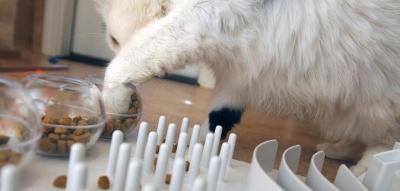
Using Food Puzzles for Dogs, Cats, and Other Pets
One of the similarities our pets share with their wild counterparts is their desire to forage for their food. Foraging provides both mental and physical engagement and helps them feel fulfilled, confident, and happy. It also gives our pets a "job" and enables them to make decisions, which will help them to be mentally and behaviorally healthy and can help to alleviate behavioral issues.
That's where food puzzles for dogs, cats, and other pets come in. Puzzle toys — also known as foraging toys, puzzle feeders, treat dispensers, and snuffle mats — allow animals to forage for food. They’re the easiest, most convenient way for people to give their feathered and furry friends a job to do, keeping both their minds and bodies busy. Food puzzles are also great for pets who wolf down their meals because the animal must eat more slowly and therefore can savor the food a bit more.
Home starts with you
How to use food puzzles for dogs, cats, and other pets
There are many different kinds of food puzzles — geared for various animal species, skill levels, and preferences — available for purchase at pet supply stores. Some of our favorites are the products made by Kong, Busy Buddy, Nina Ottosson, Creative Foraging Systems, and PetSafe. You can also make your own DIY pet food puzzles from common household objects.
Before you start buying or making a bunch of food puzzles for your pets, though, it’s important to understand a few things:
- Animals aren’t born with foraging skills. In the wild, their family members teach them how to forage for food. In a home environment, it’s our job to teach them. Just as we begin with learning simple tasks and work our way up to mastering more complex ones, most companion animals must start with simple food puzzles and gradually take on more challenging puzzles as they gain skill.
- Not all animals learn at the same speed. Just because your friend’s dog immediately figured out how to use that more advanced food puzzle doesn’t mean your dog is going to pick things up just as quickly. There are different kinds of intelligence, so be patient with your pet’s learning curve.
- Consider the food you’re putting in the puzzle. What do you put in a food puzzle anyway? If your pet doesn’t seem interested in a puzzle toy — even the easiest one you can find — try switching the type of food you’re using in the toy. Instead of kibble, try filling the food puzzle with special treats that you know your pet likes. Then, after your pet understands what a food puzzle is and starts to enjoy playing with it, you can start incorporating less exciting foods.
- Animals have different play styles and toy preferences. Food puzzles come in lots of shapes, sizes, colors, and textures. If your pet doesn’t like one type of food puzzle, don’t give up. There are many different kinds, and your pet just might not be dazzled by that particular one. Every animal is an individual, and figuring out what each of them likes is part of the fun of having pets.
The options for pet food puzzles are nearly limitless. A quick online search will yield dozens of websites that sell food puzzles for a wide variety of species, and just as many sites offer ideas on DIY pet food puzzles.
DIY puzzle toys for pets
Here are a few simple ideas for creating DIY food puzzles for pets. As with any new toy that you offer, supervise your pet while they're occupied with the puzzle to make sure they don't ingest the inedible parts.
- For a dog: Start by offering food out of a cardboard box with one whole side cut away, and then start offering boxes with less and less of the side removed until the dog can get the food out of a completely closed box. Another idea is to put kibble or treats in the cups of a muffin tin, cover each cup with a tennis ball, and encourage your pup to find the kibble.
- For a cat: Fill a small paper cup with wet food, tie a string to it, and suspend it a few inches in the air. Another option is to collect various sizes of clean plastic containers and small boxes, arrange them on a tray, and put a few treats or pieces of kibble in each.
- For a parrot: Offer small amounts of food on pieces of paper, and then put the food in a loosely crumpled piece of paper. Gradually crumple the paper more and more until your parrot can get the food out of a tightly wrapped paper ball.
Inspired to get creative? Put aside those boring old food bowls, and start teaching your pets how to play with their food.
